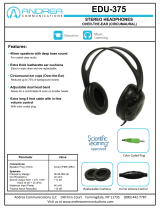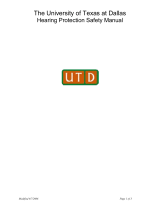
[10] Berger, E. H. and Kerivan, J. E. (1983). "Influence of Physiological Noise and the Occlusion Effect on
the Measurement of Real-Ear Attenuation at Threshold," J. Acoust. Soc. Am. 74(1), 81-94.
[11] BSI (1983). "Measurement of Sound Attenuation of Hearing Protectors," British Standards Institution,
BS 5108:1983, London, England.
[12] Burkhard, M. D. and Sachs, R. M. (1975). "Anthropometric Manikin for Acoustic Research," J. Acoust.
Soc. Am. 58(1), 214-222.
[13] Burks, J. A. and Michael, K. L. (2003). "A New Best Practice for Hearing Conservation: The Exposure
Smart Protector (ESP)," in
Proceedings of Noise-Con 2003, edited by D. K. Holger and G. C. Maling,
Jr., Inst. Noise Control Eng. USA, Washington, DC, paper 009.
[14] Casali, J. G., Mauney, D. W., and Burks, J. A. (1995). "Physical versus Psychophysical Measurement of
Hearing Protector Attenuation - a.k.a. MIRE vs. REAT," Sound and Vibration 29(7), 20-27.
[15] Gauger, D. (2003). “Testing and Rating of ANR Headsets,” U. S. EPA Workshop on Hearing Protector
Devices, Washington, DC.
[16] Gauger, D. and Berger, E. H. (2004). “A New Hearing Protector Rating: The Noise Reduction Statistic
for Use with A Weighting (NRS
A
),” report prepared at the request of the U. S. EPA, reviewed and
approved by ANSI S12/WG11, E•A•R 04-10/HP, Indianapolis, IN.
[17] IS (1971). "Method of Measurement of Real-Ear Attenuation of Ear Protectors at Threshold," Indian
Standard, IS:6229-1971, New Delhi, India.
[18] ISO (1981). "Acoustics - Measurement of Sound Attenuation of Hearing Protectors - Subjective
Method," International Organization for Standardization, ISO 4869, Switzerland.
[19] ISO (1990). "Acoustics - Hearing Protectors - Part 1: Subjective Method for the Measurement of Sound
Attenuation," International Organization for Standardization, ISO 4869-1:1990(E), Switzerland.
[20] ISO (1989). "Acoustics - Hearing Protectors - Part 3: Simplified Method for the Insertion Loss of
Earmuff Type Hearing Protectors for Quality Inspection Purposes," International Organization for
Standardization, ISO 4869-1:1989(E), Switzerland.
[21] JSA (1983). "Ear Protectors," Japanese Industrial Standard, JIS T 8161-1983, Tokyo, Japan.
[22] Knaus, D. A. and Dietz, A. J. (2004). “An Objective Method for Measuring the Attenuation of Hearing
Protection Devices Using Otoacoustic Emissions,” J. Acoust. Soc. Am. 116 (4), Pt. 2, p. 2596.
[23] Letowski, T., Burstein, N., Clark, J., Romanowski, L., and Sevec, A. (1995). "Most Comfortable
Loudness Shift as a Measure of Speech Attenuation by Hearing Protectors," Am. Ind. Hyg. Assoc. J.
56(4), 356-361.
[24] May, B. S. and Dietz, A. J. (2004). “Skull Simulator for Design of Hearing Protection Systems for
Bone-Conducted Sound,” J. Acoust. Soc. Am. 116 (4), Pt. 2, p. 2625.
[25] Parmentier, G., Dancer, A., Buck, K., Kronenberger, G., and Beck, C. (2000). "Artificial Head (ATF)
for Evaluation of Hearing Protectors," Acta Acustica 86(5), 847-852.
[26] Russell, M. F. and May, S. P. (1976). "Objective Test for Earmuffs," J. Sound Vib. 44(4), 545-562.
[27] SA/SNZ (2002). "Acoustics - Hearing Protectors," Standards Australia and Standards New Zealand,
1270:2002, Sydney, NSW.
[28] Schroeter, J. and Els, H. (1982). "On Basic Research Towards an Improved Artificial Head for the
Measurement of Hearing Protectors," Acustica 50(4), 250-260, and 51(6), 302.
[29] Schroeter, J. and Poesselt, C. (1986). "The Use of Acoustical Test Fixtures for the Measurement of
Hearing Protector Attenuation. Part II: Modeling the External Ear, Simulating Bone Conduction, and
Comparing Test Fixture and Real-Ear Data," J. Acoust. Soc. Am. 80(2), 505-527.
[30] Wargowske, J., Fedtke, T., and Richter, U. (1995). "Insertion Loss of Ear-Plugs, Measured on New
Versions of Two Commercially Available Head and Torso Simulators," PTB-Bericht, PTB-MA-43,
Braunschweig, Germany.














